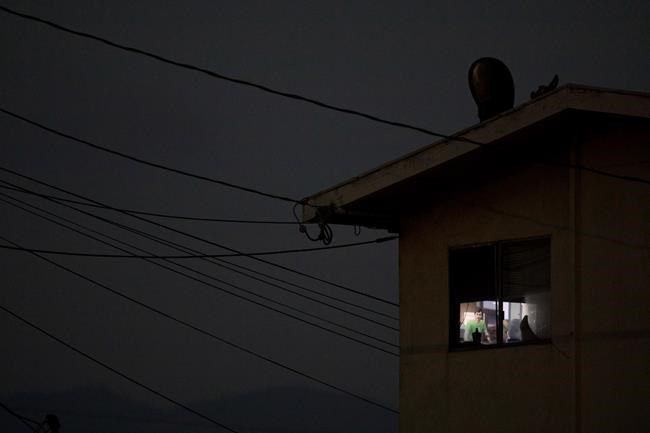
In this Thursday, Sept. 6, 2018, photo, electrical wires run into an apartment building as a room is lit by a TV screen in Salinas, Calif. Nearly a quarter of the state's resident's live in poverty, the highest rate in the country, according to the U.S. Census Bureau. Median annual earnings in the state rose by a fraction of the increase in housing costs from 2006 to 2016, according to the California Budget and Policy Center. (AP Photo/Jae C. Hong)
October 17, 2018 - 10:47 PM
SALINAS, Calif. - Middle-school English teacher Maryam Powers doesn't take vacations. To earn additional money, she picks up an extra period of teaching when she can and mentors new hires. But to afford the mortgage on a $330,000 three-bedroom home she purchased in Salinas in 2015, Powers still must rent out the master bedroom for $800 a month.
"I work, work, work, work, work. I take every extra pay job I can do, and I never quite get ahead," said Powers, who shares the home with her boyfriend and their two young children.
Powers' family is reflective of many in this California city just inland from the tourism-rich Monterey Peninsula and an hour's drive south of Silicon Valley. It's surrounded by farmland that produces most of the world's lettuce and inspired hometown author John Steinbeck's "The Grapes of Wrath."
Salinas is one of America's least affordable places to live, exemplifying a housing crisis that plagues California's rural and urban areas alike. Salinas families earn a median income of $69,000, while the region's 90,000 farmworkers bring in far less. They face a median home price of nearly $550,000 and two-bedroom apartments costing roughly $1,800 a month, according to Zillow.
Frustration is mounting over expensive housing, and some Californians hope a November ballot measure on rent control provides relief.
California politicians can't ignore the issue as they try to balance people's needs in a state that's home to extreme riches but also places like Salinas, where multiple generations pack single-family homes, people turn backyard sheds into illegal bedrooms and families worry over how to pay their bills.
Residents know rent control isn't the best long-term solution — economists widely agree it cuts down on building — but they're eager to help their struggling neighbours.
"Our rents are too high. Something needs to be done," said Noelia Verwulf, a Salinas resident who helped form a group called Viviendas para Todx or "Housing for All" that's holding community forums, registering people to vote and advocating for housing-related ballot measures. "It's a temporary fix."
Four of the 11 ballot measures facing California voters, including rent control, relate to housing.
The Salinas metro area is one of seven in California that ranks in the top 10 least affordable in the U.S., according to an analysis of 2016 census data by Harvard's Joint Center for Housing Studies. Sprawling Los Angeles, wealthy Santa Barbara and rural Redding also make the list.
The federal government considers housing unaffordable if it eats up over a third of a family's income. More than half of California renters and nearly a third of homeowners spend that much or more.
To save money, Powers, 39, and her boyfriend, Jean-Paul Varagnat, rented out the master bedroom of someone else's home — an arrangement she repeated at her own house to afford her $2,300 monthly mortgage.
"I knew I was never going to be wealthy, but I didn't think it was going to be quite this difficult," Powers said.
There is mixed reaction to Proposition 10, the ballot measure that would scrap a law restricting rent control on single-family homes and properties built after 1995 and open the door for new local rules about how much landlords can increase rents.
Democrat Anna Caballero, who represents Salinas in the state Assembly, opposes the measure but said she understands why the residents support it.
It feels like "the only thing you can do to get the attention of people who own rental housing units is to do something drastic," she said.
Interviews with roughly two dozen Salinas residents reveal a general belief that local, state and national politicians lack a grip on the reality of the region's housing crisis. Few said it would motivate them to vote for a different party, instead calling it one of many issues that revealed a need for fresh voices.
The Nunez family has three generations and 15 members jammed into a four-bedroom home. Jose Nunez and his wife live with three of their six children and their spouses and seven grandchildren. Each family has a bedroom.
Nunez didn't expect his children to be back at home but wouldn't turn them away when two lost their houses to foreclosure. His son Miguel now struggles to find an affordable house for his family that won't require them to live paycheque to paycheque, said Miguel's wife, Sasha.
"You get comfortable and you're happy here," she said. "But there's nothing like having your own place."
Salinas soon hopes to build more than 10,000 homes on an edge of town covered by fields. Repurposing farmland is seen as the best option for finding space though it takes away part of the city's lifeblood.
Some are concerned it won't be enough. A plan to bring commuter rail from Silicon Valley to Salinas could make the new homes a cheaper alternative for tech workers.
"We have an insatiable need for housing," City Councilman Scott Davis said. "No matter how much housing we build, we'll never have enough."
___
This report is part of a series on how California's struggles with soaring housing costs, job displacement and a divide over liberal policies are affecting the November election. See full coverage at: https://apnews.com/CaliforniaataCrossroads
News from © The Associated Press, 2018